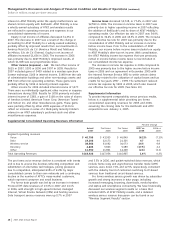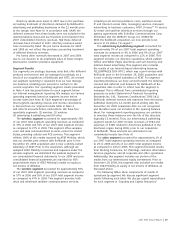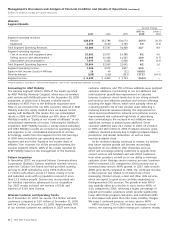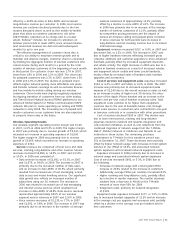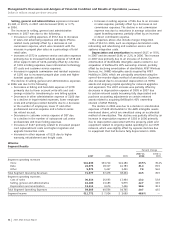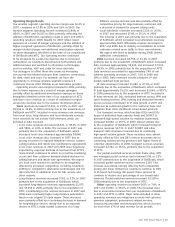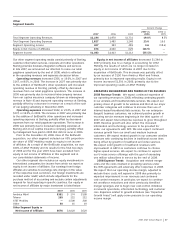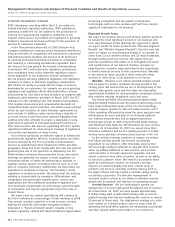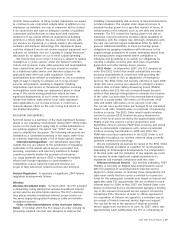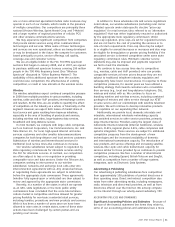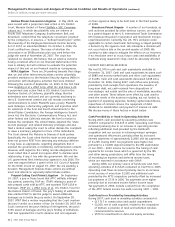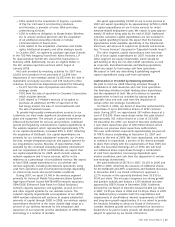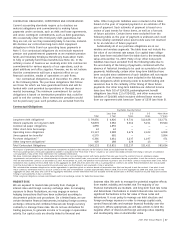AT&T Wireless 2007 Annual Report Download - page 40
Download and view the complete annual report
Please find page 40 of the 2007 AT&T Wireless annual report below. You can navigate through the pages in the report by either clicking on the pages listed below, or by using the keyword search tool below to find specific information within the annual report.
Management’s Discussion and Analysis of Financial Condition and Results of Operations (continued)
Dollars in millions except per share amounts
38
| 2007 AT&T Annual Report
OPERATING ENVIRONMENT OVERVIEW
AT&T subsidiaries operating within the U.S. are subject to
federal and state regulatory authorities. AT&T subsidiaries
operating outside the U.S. are subject to the jurisdiction of
national and supranational regulatory authorities in the
markets where service is provided, and regulation is generally
limited to operational licensing authority for the provision of
services to enterprise customers.
In the Telecommunications Act of 1996 (Telecom Act),
Congress established a national policy framework intended to
bring the benefits of competition and investment in advanced
telecommunications facilities and services to all Americans
by opening all telecommunications markets to competition
and reducing or eliminating burdensome regulation. Since
the Telecom Act was passed, the Federal Communications
Commission (FCC) and some state regulatory commissions
have maintained many of the extensive regulatory require-
ments applicable to our traditional wireline subsidiaries.
We are actively pursuing additional legislative and regulatory
measures to reduce or eliminate regulatory requirements
that inhibit our ability to provide the full range of services
demanded by our customers. For example, we are supporting
regulatory and legislative efforts that would offer a stream-
lined process for new video service providers to compete with
traditional cable television providers. In March 2007, the FCC
released an order adopting rules that prohibit municipalities
from making unnecessary and unreasonable demands on
competitive video service providers, and which require prompt
action by such localities on cable franchise applications by
new entrants. In addition, states representing a majority of
our local service access lines have adopted legislation that
enables new video entrants to acquire a statewide or state-
approved (as opposed to municipal-approved) franchise to
offer video services. We also are supporting efforts to update
regulatory treatment for retail services. Passage of legislation
is uncertain and depends on many factors.
Our wireless operations are likewise subject to substantial
governmental regulation. Wireless communications providers
must be licensed by the FCC to provide communications
services at specified spectrum frequencies within specified
geographic areas and must comply with the rules and policies
governing the use of the spectrum as adopted by the FCC.
While wireless communications providers’ prices and service
offerings are generally not subject to state regulation, an
increasing number of states are attempting to regulate or
legislate various aspects of wireless services, such as in the
area of consumer protection. Additionally, we have noted our
opposition to proposals to impose “net neutrality” access
regulation on wireless providers. We believe that the wireless
industry is characterized by innovation, differentiation and
competition among handset manufacturers, carriers and
appli cations and that additional broadband regulation and
new wholesale requirements are unnecessary given the state
of competition and may be appropriate only in the case of
market failure.
We expect that our capital expenditures will continue to
be in the midteens as a percentage of total revenues in 2008.
This amount includes capital for U-verse services, wireless
high-speed networks and merger-integration projects
(discussed in “Expected Growth Areas”). Despite a more
positive regulatory outlook and these broadband opportunities,
increasing competition and the growth of alternative
technologies such as cable, wireless and VoIP have created
significant challenges for our business.
Expected Growth Areas
We expect our wireless services and primary wireline products
to remain the most significant portion of our business and
have also discussed trends affecting the segments in which
we report results for these products (see “Wireless Segment
Results” and “Wireline Segment Results”). Over the next few
years we expect an increasing percentage of our growth to
come from: (1) our wireless service, and (2) data/broadband,
through existing and new services. We expect that our
previous acquisitions will enable us to strengthen the reach
and sophistication of our network facilities, increase our
large-business customer base and enhance the opportunity
to market wireless services to that customer base. Whether,
or the extent to which, growth in these areas will offset
declines in other areas of our business is not known.
Wireless Wireless is our fastest-growing revenue stream
and we expect to deliver continued revenue growth in the
coming years. We believe that we are at the beginning of the
wireless data growth curve and that there are substantial
opportunities available for next-generation converged services
that combine wireless, broadband, voice and video.
Our Universal Mobile Telecommunications System/High-
Speed Downlink Packet Access 3G network technology covers
most major metropolitan areas of the U.S. This technology
provides superior speeds for data and video services, and it
offers operating efficiencies by using the same spectrum and
infrastructure for voice and data on an IP-based platform.
Our wireless networks also rely on digital transmission
technologies known as GSM, General Packet Radio Services
and Enhanced Data Rates for GSM Evolution for data commu-
nications. As of December 31, 2007, we served more than
70 million customers and are the leading provider of mobile
wireless voice and data communications services in the U.S.
As the wireless industry continues to mature, we believe
that future wireless growth will become increasingly
dependent on our ability to offer innovative services that
will encourage existing customers to upgrade their services,
either by adding additional or new services, such as data
enhancements, or through equipment upgrades, and will
attract customers from other providers, as well as our ability
to minimize customer churn. We intend to accomplish these
goals by continuing to expand our network coverage,
improve our network quality and offer a broad array of
products and services, including exclusive devices such as
the Apple iPhone and free mobile-to-mobile calling among
our wireless customers. The effective management of
customer churn is critical to our ability to maximize revenue
growth and to maintain and improve our operating margins.
U-verse Services We are continuing to expand our
deployment of U-verse high-speed broadband and TV services.
As of December 31, 2007, we have passed approximately
8 million living units (constructed housing units as well as
platted housing lots) and are marketing the services to almost
50 percent of those units. Our deployment strategy is to enter
each market on a limited basis in order to ensure that all
operating and back-office systems are functioning successfully
and then expand within each market as we continue to


